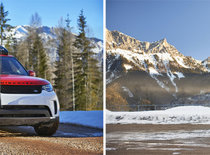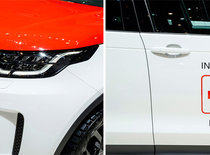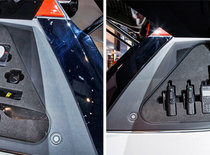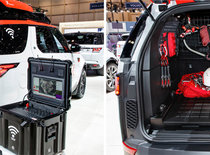Land Rover Discovery Project Hero Created to Assist Red Cross in Saving Lives
June 15 2018, Land Rover Vancouver

INNOVATIVE DRONE TECHNOLOGY TO QUICKEN SEARCH AND RESCUE RESPONSE TIMES
When the word “bespoke” is used in the same sentence as “Jaguar Land Rover” one tends to think of the highest quality leathers, veneers, wool carpets and convenience features rather than an “Advanced Command Vehicle” with integrated shortwave and GPS comm equipment, specialized toolkits, climbing gear, and power supplies, let alone a power-retractable covered landing pad for an onboard drone; and likewise when JLR’s Special Vehicle Operations (SVO) gets mentioned it’s usually in tandem with “Premium Paint Palette” finishes, Sentinel armoured vehicles, SVR and SVAutobiography halo models, or previously noted bespoke personalization, but in this case it’s an orange and white search and rescue vehicle created by SVO for the Red Cross.
This “bespoke” 2017 Land Rover Discovery, dubbed ‘Project Hero’, was designed and engineered by Jaguar Land Rover’s Special Vehicle Operations for the Austrian Red Cross and presented to global media at the Geneva auto show earlier this month. An advanced communication vehicle, Project Hero was created to support JLR’s strategic partnership with the International Federation of Red Cross and Red Crescent Societies (IFRC), the world’s largest humanitarian network.
For the project, SVO worked together with the Austrian Red Cross to develop a specialized Land Rover Discovery to be used by their emergency response teams on a trial basis, in hopes that it would help save lives by speeding up emergency response times.
LAND ROVER HAS SUPPORTED THE RED CROSS SINCE 1954
The Land Rover and Red Cross relationship goes back 64 years, having supplied 120 vehicles for deployment around the world. Currently, Land Rover supports 18 humanitarian projects in 25 countries. Project Hero is unique to previous offerings, however, in that it’s the first to feature an integrated roof-mounted drone.
Similar in concept to a helicopter pad on a coast guard ship’s deck, the drone can take off and land atop the Discovery’s roof via an innovative landing system. The drone is actually held in place via a self-centering and magnetic retention system, technologies that have never been used like this before. The drone is therefore fastened securely in place even when the Discovery is covering rugged terrain that might otherwise loosen mechanical grips and cause damage. Once arriving at a point of operation, a rooftop cargo box-style canopy is powered back to expose the landing pad, thus allowing the drone to immediately respond to an emergency without the need of direct human interaction. From the safety of the vehicle, the controller deploys the drone via a tablet app that lets occupants assess the surrounding environment and potentially find survivors as the driver keeps the teaming moving forward.
When the drone is airborne, live footage can be transmitted real-time to Red Cross emergency response teams in order to help them react more quickly to search and rescue operations, the drone, which can reach speeds of up to 54 km/h (33.5 mph), especially effective in disaster struck areas such as avalanches, landslides, floods, and earthquakes due to its ability to fly over terrain that might be impassable to a vehicle.
HOST OF CUSTOMIZED RESCUE EQUIPMENT JOINS ROOFTOP DRONE
Along with the drone and innovative launch system, this special Discovery is filled with search and rescue equipment such as multiple frequency radio equipment, power supply points in and outside the vehicle, strategically positioned LED lights to aid night vision, a panel behind the rear seats to section off the passenger and cargo areas and provide additional equipment mounting points, a heavy-duty sliding cargo floor that can be used as a work surface, a toolkit housed under the cargo floor, an additional toolkit and comm equipment fitted beneath the driver’s and passenger’s side rear quarter windows respectively, climbing equipment, first aid kits, and more.
Working on Project Hero is as good as it gets for Land Rover and its team of engineers and designers at SVO, who are honoured to be involved in the IFRC’s humanitarian effort.
“Land Rover and the team of engineers and designers at SVO are proud to support the incredible humanitarian work of the IFRC and its members,” said John Edwards, Jaguar Land Rover Special Operations Managing Director. “The new Discovery is an outstanding all-terrain SUV, and Project Hero is the optimum combination of enhanced capability and innovative technology. We hope to help the Red Cross save lives in emergency situations.”
NEW DISCOVERY DESIGNED FOR REMOTE RESCUE CAPABILITY FROM ONSET
Thanks to the new Discovery, which was designed for extreme off-road conditions just like its LR4 predecessor and the many Land Rovers that have come before, this special Project Hero SUV can traverse challenging obstacles to safely arrive at remote locations, the brand’s legendary four-wheel drive capability and innovative Terrain Response system combining with JLR’s powerful yet fuel-efficient 3.0-litre TD6 turbo-diesel engine and eight-speed automatic transmission to get the job done.
“We are grateful to Land Rover for their generous support over the past 60 years, and are proud of our ambitious global partnership that has transformed the lives of millions of people on four continents,” said Dr. Jemilah Mahmood, IFRC Under Secretary General for Partnerships. “The partnership is supporting communities around the world to become more resilient in the face of natural disasters such as monsoons, flooding and earthquakes. Project Hero combines the best expertise of the Red Cross and Jaguar Land Rover to create a truly unique vehicle, which we hope will be capable of making a difference to rescue operations in the toughest environments.”
While the Austrian Red Cross headquarters is in Vienna, the Project Hero Discovery will most often be stationed at a training centre in Erzberg, which is found in the mountainous mining region of Eisenerz, for 12 months starting June 2017. The Red Cross will use the drone in its rescue simulations in a quest to develop new and innovative techniques for disaster relief. The test-runs will include complex natural disaster scenarios, such as deployment at night and within dense forests. If Project Hero proves successful, JLR and the IFRC will likely deploy more examples to be used in their collaborative search and rescue efforts around the world.
There's also a very well produced video that shows the drone and special Discovery in operation here:
Story credits: Trevor Hofmann, Canadian Auto Press
Photo credits: Land Rover
Copyright: Canadian Auto Press Inc.
Date Posted: June 6, 2017






